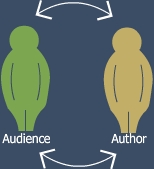Shen, Dan. “Neo-Aristotelian Rhetorical Narrative Study: Need for Integrating Style, Context, and Intertext. Style 45:4 (Winter 2011): 576-597. Print.
****************************
Second generation neo-Aristotelian critical theory arose in the early sixties as an extension of the Chicago School of Criticism, led by prominent scholar Wayne C. Booth in his seminal work, The Rhetoric of Fiction (U. of Chicago Press, 1961, 1983). Booth’s work extended first generation work by Robert S. Crane, which offered literary scholars a critical lens that considered the poetics of a text (how it functioned as a narrative structure within its genre, marginalizing language or “the text itself”) to the rhetorical nature of narrative fiction, with its “implied author” and author-audience communication.
Shen distinguishes the three generations of Chicago School, briefly outlining the Aristotelian premise of the first-generation and then focusing his argument on the second and third generation of neo-Aristotelian critics. His work here is mostly a defense and a definition of what Neo-Aristotelian criticism is, differentiating between rhetorical criticism’s focus on the “narratological distinction between story and discourse” (577), which distinguishes between “what” is written (structure) and “how” an author conveys the story (verbal) (578). This is essentially an argument about the function of character, event, discourse, and style, and how these choices create a norm for the “implied author;” that is, the “second self” of the writer that is revealed by an analysis of the narrator-author within the text (583). This gives us an opportunity to study the rhetorical relationship between the audience and the author, which further reveals the cognitive and affective elements of a text. The author-audience communication “investigates the communication between the implied author and her ideal, hypothetical addressee” (579). Indeed, much of third-generation rhetorical critics are using Booth as their central unifying force to argue for an how this approach enables scholars to understand how texts act upon the reader and what “means the author uses to persuade a reader” (583). This is important because it moves us beyond New Criticism’s focus on language out of context, but invites in those contexts by allowing a “communication between the author and the reader” as well as an investigation into how “flesh-and-blood readers’ different experiences, knowledge, and sociohistorical positioning lead to divergent readings” (583, 584). As an approach to analyze texts for their rhetorical impact on readers as well as how texts fit contextually within a genre, neo-Aristotelian criticism would seem to bridge many of the theoretical divides confronting literary studies.
Shen is able to give both a historical perspective as well as a current definition of this field of literary criticism, and offers as objects of study a critical approach that goes beyond “the text itself,” in that it argues for a more holistic look at the production and effect of fictional narratives. He draws not only upon the seminal work of R.S. Crane and Booth (first and second generation Chicago School critics), but synthesizes the current third generation work of scholars such as James Phelan. Shen spends a good amount of time with real examples of how this theory is applied to texts, such as Katherine Mansfield’s “Revelations” and Edgar Allen Poe’s “The Tell-Tale Heart” (581-582). His argument here is to question the exclusion of the “real author,” because generally, no biographical data on the real author is used in rhetorical criticism, only the implied author. Instead, he argues that understanding the biography of the real author, such as knowing Kate Chopin’s biographical background when writing “Desiree’s Baby,” helps readers and scholars to understand the racial implication and the “mythologization of Southern racist culture” in this story[1], which, without that knowledge, would be obscured. Despite this argument, Shen emphatically goes on to assert the primacy of the text in any rhetorical analysis.
Finally, Shen discusses genre, noting Aristotle’s emphasis on genre and Booth’s argument that even the “least conventional story” will bring with a set of generic expectations on the part of the scholar/reader (588). This, Shen argues, “intertextual comparison” allows scholars to deepen their rhetorical analysis of texts even further, by comparing the “structure-style features between the text under investigation and other related texts” (588). Once again, this is to further understand the norms of the implied author, especially as we trace authorial movements between texts.
****************************
[1] Shen also discusses how using the real author’s biographical data can help us understand narratological events and characters such as the narrator in Poe’s “The Tell-Tale Heart.” In this example, he notes that analysis of this short story often tries to explain why the narrator “continuously insists on his sanity, a textual phenomenon that has received various interpretations but none appear convincing” (586). Shen observes that at this time there was a contemporary legal defense beginning to take hold in the United States: the “insanity defense.” This lends an even higher ironic element to the story that may not have been understood without this background knowledge (587).

